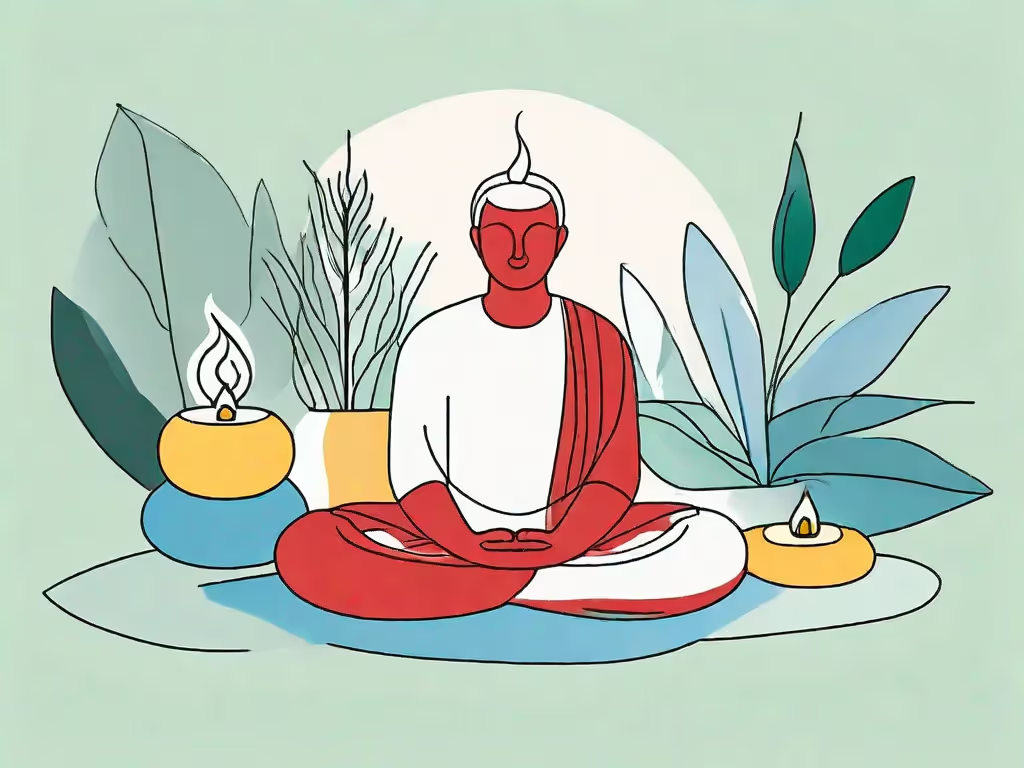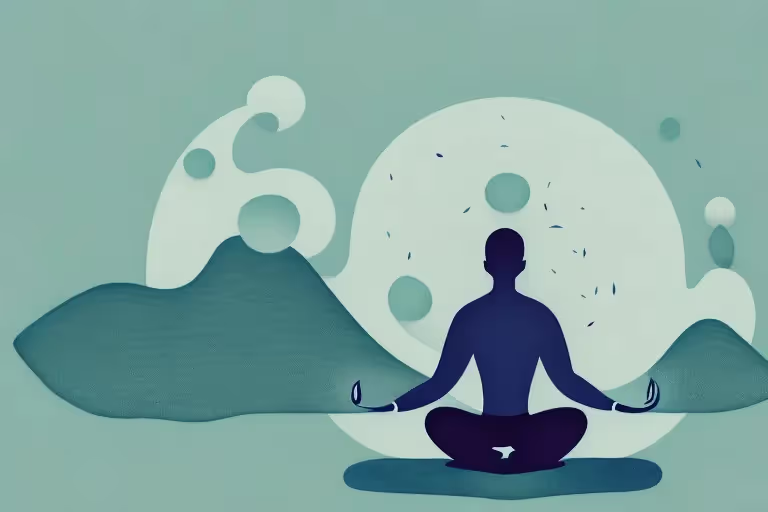Colors play a vital role in our lives. They not only add vibrancy and beauty to our surroundings but can also have a profound impact on our emotions and mental well-being. In the realm of meditation, colors take on even greater significance. Each color represents different energies and can help enhance our meditation practice in unique ways. In this article, we will delve into the concept of colors in meditation, explore the significance of different colors, discuss ways to incorporate colors into our practice, uncover the benefits of color meditation, and dispel common misconceptions surrounding this powerful method. So, let's embark on this colorful journey and unlock the hidden potential of meditation!
The Concept of Colors in Meditation
When we talk about the concept of colors in meditation, we are referring to the use of specific colors to enhance our focus and deepen our experiences. Colors are believed to resonate with different chakras, which are energy centers in our body that correspond to various aspects of our physical, emotional, and spiritual well-being.
In the practice of meditation, colors play a significant role in creating a harmonious and balanced environment. By incorporating specific colors into our meditation practice, we can tap into their unique vibrations and energies, allowing us to connect with our inner selves on a deeper level.
Let's explore the fascinating world of colors in meditation and discover how they can enrich our spiritual journey.
The Role of Colors in Meditation
Each color has its own unique vibration and energy. By meditating on specific colors, we can activate and balance the corresponding chakras, allowing the free flow of energy throughout our being. For example, meditating on the color red can stimulate the root chakra, which is associated with our sense of stability and grounding. On the other hand, meditating on blue can activate the throat chakra, enabling us to express ourselves more effectively and communicate our truth.
By understanding which color corresponds to which chakra, we can target specific areas of our life that may need healing or enhancement. For instance, if we are experiencing difficulties in expressing ourselves honestly, we can focus our meditation on the color blue to strengthen our throat chakra and improve our communication skills.
Colors have the power to awaken dormant energies within us and bring balance to our physical, emotional, and spiritual well-being. By incorporating a variety of colors into our meditation practice, we can create a holistic approach to healing and self-discovery.
The Psychological Impact of Colors
Beyond their association with chakras, colors also have a profound psychological impact on our minds. Research has shown that different colors can elicit varying emotions and moods. For example, warm colors like red and orange tend to evoke feelings of passion and energy, while cool colors like blue and green evoke a sense of calmness and tranquility.
By incorporating these colors into our meditation practice, we can harness their psychological effects to create the desired atmosphere for inner exploration and healing. If we seek a sense of tranquility and peace during our meditation, we can surround ourselves with shades of blue and green. These colors will help us relax our mind and body, allowing us to delve deeper into our meditation practice.
On the other hand, if we are in need of a boost of energy and motivation, we can introduce vibrant and warm colors like red and orange into our meditation space. These colors can invigorate our senses and ignite our passion, enabling us to approach our meditation practice with renewed vigor and enthusiasm.
Colors have a profound impact on our emotions and can greatly influence our state of mind. By consciously selecting and incorporating specific colors into our meditation practice, we can create a supportive and nurturing environment that aligns with our intentions and goals.
As we embark on our meditation journey, let us embrace the power of colors and explore the endless possibilities they offer for self-discovery, healing, and spiritual growth.
The Significance of Different Colors
Now that we understand the concept and role of colors in meditation, let's explore the significance of different colors and how they can enhance our practice.
The Power of Red in Meditation
Red is often associated with vitality, strength, and passion. Meditating on the color red can help increase our physical energy, ignite our motivation, and stimulate the root chakra, which is responsible for our sense of safety and stability. When we need an extra boost of energy or when we're feeling lethargic, visualizing the color red during meditation can help revitalize us and awaken our dormant potential.
The Calmness of Blue in Meditation
On the other hand, blue is known for its calming and soothing properties. It is often associated with peace, tranquility, and clear communication. Meditating on the color blue can help us relax, release stress, and activate the throat chakra, enabling us to express ourselves authentically and communicate our truth. When we find ourselves overwhelmed or in need of inner peace, visualizing the color blue can provide a sense of serenity and balance.
The Energy of Yellow in Meditation
Yellow is a color that radiates brightness, optimism, and joy. It is associated with the solar plexus chakra, which governs our personal power and self-confidence. Meditating on the color yellow can help boost our self-esteem, enhance our creativity, and invite abundance into our lives. When we seek more positivity and enthusiasm, visualizing the color yellow during meditation can uplift our spirits and fill us with renewed energy.
Incorporating Colors into Your Meditation Practice
Now that we understand the significance of different colors, it's time to explore how we can incorporate them into our meditation practice.
Visualizing Colors During Meditation
One powerful way to utilize colors during meditation is through visualization. Close your eyes, take a few deep breaths, and imagine a specific color surrounding you or filling your body. Visualize this color permeating every cell, bringing its unique energy to each part of your being. You can also visualize the color flowing through the corresponding chakra, allowing it to balance and harmonize.
Using Colored Objects in Meditation
Another way to incorporate colors into your practice is by using colored objects. Place an object of the chosen color in front of you during meditation. It can be a crystal, a flower, or any item that represents the color you wish to work with. By focusing your gaze on this object, you can deepen your connection with the energy it represents and enhance your overall meditative experience.
The Benefits of Color Meditation
Emotional Healing Through Color Meditation
Color meditation can be a powerful tool for emotional healing. Each color corresponds to specific emotions and can help us address any imbalances or blockages we may be experiencing. By meditating on the appropriate color, we can release emotional pain, restore harmony, and foster emotional well-being. Whether we are dealing with grief, anxiety, or stress, color meditation offers a gentle yet effective way to find solace and bring light into our lives.
Enhancing Focus and Concentration with Colors
Color meditation can also enhance our focus and concentration. By directing our attention to a particular color, we naturally train our minds to stay centered and present. This focused awareness can then be applied to other areas of our life, allowing us to be more attentive, productive, and engaged in our daily activities. Additionally, color meditation can help quiet the incessant chatter of the mind, providing us with a sense of inner stillness and clarity.
Misconceptions About Color Meditation
Debunking Common Myths
Despite the numerous benefits and growing popularity of color meditation, there are still some misconceptions surrounding this practice. One common myth is that color meditation is purely a form of visualization and does not hold any real value. However, countless individuals have experienced profound transformations and healing through color meditation, making it far more than just a figment of the imagination.
Understanding the True Essence of Color Meditation
Another misconception is that color meditation is only for spiritual or esoteric individuals. In reality, anyone can benefit from this practice, regardless of their beliefs or background. Color meditation is about tapping into the universal language of colors and utilizing their inherent energies to enhance our well-being. It is a versatile and accessible tool that can be embraced by people from all walks of life.
In conclusion, understanding the significance of colors in meditation opens up a world of possibilities and deeper experiences. By incorporating different colors into our practice, we can harness their unique vibrations and energies to facilitate healing, enhance focus, and cultivate a greater sense of self-awareness. So, the next time you sit down for meditation, don't forget to infuse your practice with the power of colors. Let them guide you on your journey of self-discovery and transformation.
Discover how colors can elevate your meditation experience with the Aura Health App.
Aura is Your All In One App for Meditation, Mindfulness Wellbeing
Find peace every day with one app for your whole well-being. There is no one-size-fits-all solution to mental well-being. Aura is the first all-in-one wellness app that learns how to best help you. Discover an endless library of expert-created tracks for your well-being, all taught by the world’s best coaches, therapists, and storytellers. With Aura's personalized recommendations, you can find peace every morning, day and night.



.webp)






.avif)

%20(1).avif)


.avif)
.avif)
.webp)


.avif)


















































































































.avif)

















.svg)









